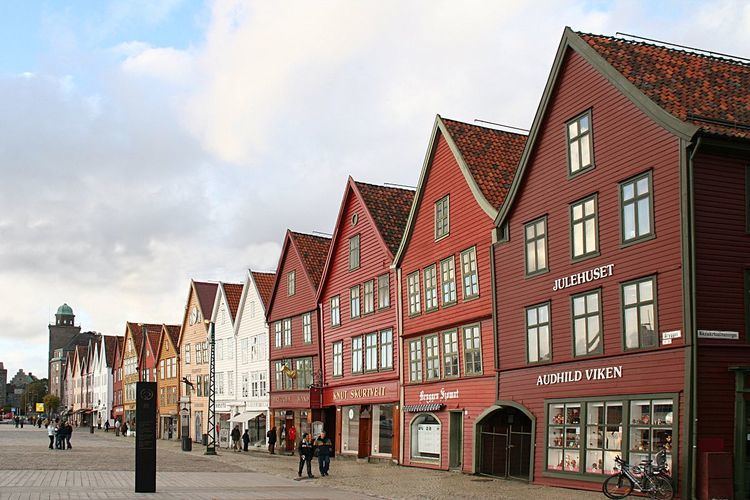Criteria iii Phone +47 55 55 20 80 | Type Cultural Reference 59 UNESCO World Heritage Site inscription 1979 | |
 | ||
Hours Closed today SundayClosedMonday9AM–4PMTuesday9AM–4PMWednesday9AM–4PMThursday9AM–4PMFriday9AM–4PMSaturday9AM–4PM Similar Fløyen, Fløibanen, Hanseatic Museum, Geirangerfjord, Ulriken | ||
World heritage sites bryggen i bergen norway 03
Bryggen (the dock), also known as Tyskebryggen ([ˈtʏskəˌbrʏɡːən], the German dock), is a series of Hanseatic commercial buildings lining the eastern side of the Vågen harbour in Bergen, Norway. Bryggen has since 1979 been on the UNESCO list for World Cultural Heritage sites.
Contents
The city of Bergen was founded around 1070 within the original boundaries of Tyskebryggen. Around 1350 a Kontor of the Hanseatic League was established there, and Tyskebryggen became the centre of the Hanseatic commercial activities in Norway. Today, Bryggen houses museums, shops, restaurants and pubs.
History
Bergen was established before 1070 AD. [Later] "in the Middle Ages, Bryggen encompassed all buildings between the road Stretet (Øvregaten) and the ocean from Holmen in the North, to Vågsbunnen in the South". Within this area, the city was founded, according to the Sagas, says encyclopedia Store Norske Leksikon.
One of the earliest pier constructions has been dated to around 1100, says Store Norske Leksikon. The existing buildings are of a much later date. "Only Schøtstuene and the buildings towards Julehuset [part of Holmedalsgården], are originals from 1702", according to guide Thomas De Ridder.
Around 1350 an office of the Hanseatic League was established there. As the town developed into an important trading centre, the wharfs were improved. The buildings of Bryggen were gradually taken over by the Hanseatic merchants. The warehouses were filled with goods, particularly stockfish from northern Norway, and cereal from Europe.
In 1702, the buildings belonging to the Hanseatic League were damaged by fire. They were rebuilt, and some of these were later demolished, and some were destroyed by fire. In 1754, the operations of the office at Bryggen, ended "when all the properties were transferred to Norwegian citizens".
Throughout history, Bergen has experienced many fires, since, traditionally, most houses were made from wood. This was also the case for Bryggen, and as of today, around a quarter dates back to the time after 1702, when the older wharfside warehouses and administrative buildings burned down. The rest predominantly consists of younger structures, although there are some stone cellars that date back to the 15th century.
Parts of Bryggen were destroyed in a fire in 1955. A thirteen-year archaeological excavation followed, revealing the day-to-day runic inscriptions known as the Bryggen inscriptions. The Bryggen museum was built in 1976 on part of the site cleared by the fire.
Architectural heritage
Bryggen was listed as a UNESCO World Heritage Site in 1979, by Criterion (iii): Bryggen bears the traces of social organization and illustrates the use of space in a quarter of Hanseatic merchants that dates back to the 14th century. It is a type of northern “fondaco”, unequalled in the world, where the structures have remained within the cityscape and perpetuate the memory of one of the oldest large trading ports of Northern Europe.
Notable houses at Bryggen include Bellgården (a 300-year-old building), Svensgården, Enhjørningsgården, Bredsgården, Bugården, Engelgården. The oldest and tallest building in the area is St Mary's Church. Streets include Jacobsfjorden. Museums include Bryggens Museum and Hanseatic Museum and Schøtstuene.
